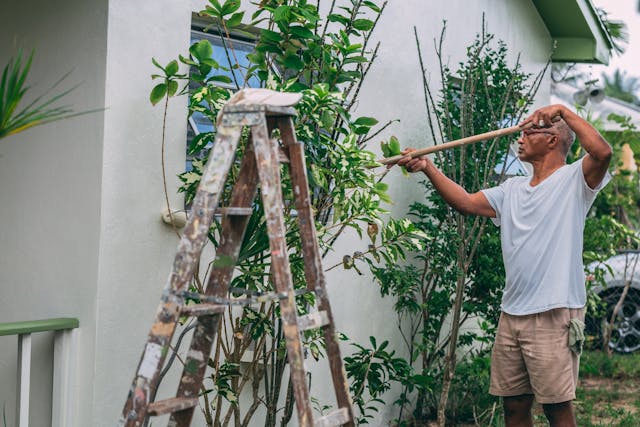Property values and home maintenance have a much stronger connection than most people realize. While everyone knows that a nice-looking house sells for more money, the real relationship goes much deeper than just curb appeal. The maintenance choices you make today can either protect your investment or slowly chip away at its value over the years.
Here’s what’s really happening – buyers and appraisers can spot neglected homes from a mile away. They know that deferred maintenance usually means bigger problems are hiding underneath. When someone sees a house that hasn’t been properly cared for, they automatically assume there are expensive repairs waiting to be discovered. This means your house gets valued lower right from the start.
The good news is that smart maintenance actually works the opposite way. When you stay on top of repairs and keep your house in good shape, buyers see it as a well-maintained property that won’t need immediate work. This lets you ask for a higher price and often helps your house sell faster than competing properties.
The Big-Ticket Items That Actually Matter
Some maintenance tasks have a huge impact on your property value, while others barely register with buyers and appraisers. Understanding which improvements give you the best return helps you spend your money wisely and protect your investment effectively.
Your roof is probably the most important single factor when it comes to property value. A roof in poor condition can knock thousands off your home’s value because buyers know roof replacement is expensive and urgent. On the flip side, a recently replaced roof can actually add value because buyers see it as one less major expense they’ll face.
The condition of your roof also affects other parts of your house’s value. When buyers see roof problems, they start wondering about water damage inside the walls, damaged insulation, and other hidden issues that come from leaks. Working with experienced roofing companies in San Luis Obispo County for regular maintenance and timely repairs can prevent these cascading value problems before they start.
Foundation issues are another huge factor in property values. Even small foundation problems make buyers nervous because they can indicate structural issues that are expensive to fix. Keeping water away from your foundation and addressing small cracks quickly prevents these concerns from affecting your home’s marketability.
Your HVAC system also plays a big role in property values. An old, inefficient heating and cooling system tells buyers they’ll face high energy bills and probable replacement costs soon. Regular maintenance keeps your system running efficiently and helps it last longer, which translates to higher property values when you sell.
The Maintenance Tasks That Pay for Themselves
Some home maintenance actually gives you back more money than you spend on it. These improvements not only protect your property value but can actually increase it beyond what you invested. Understanding these high-return maintenance tasks helps you prioritize your spending.
Exterior painting is one of the best investments you can make in terms of property value. Fresh paint doesn’t just make your house look better – it protects your siding and trim from weather damage. The return on investment for exterior painting often exceeds 100%, meaning you get back more than you spent when you sell.
Kitchen and bathroom updates also provide excellent returns, but you don’t need complete renovations to see value increases. Simple updates including new fixtures, fresh paint, and modern hardware can give these important rooms a fresh look without breaking your budget. Buyers pay close attention to kitchens and bathrooms, so keeping them updated helps your property value significantly.
Window replacement might seem expensive, but it often pays for itself through increased property value plus energy savings. New windows make your house more attractive to buyers and reduce energy costs, giving you immediate benefits while you live there plus higher resale value later.
Landscaping and yard maintenance also provide strong returns on investment. A well-maintained yard makes a huge first impression on potential buyers and can increase your property value by several thousand dollars. The key is keeping things neat and attractive rather than going overboard with expensive installations.
The Expensive Mistakes That Hurt Property Values
Just as some maintenance protects property values, other choices can actually hurt your home’s worth. Understanding these value-destroying mistakes helps you avoid spending money on improvements that don’t pay off.
Over-improving for your neighborhood is one of the biggest mistakes homeowners make. If you spend $50,000 on a luxury kitchen in a neighborhood where most houses sell for $200,000, you probably won’t get that money back when you sell. Your house’s value is limited by what similar houses in your area sell for.
Ignoring small problems until they become big ones is another value-killer. That small roof leak might only cost a few hundred dollars to fix today, but waiting until it damages your walls and floors could cost thousands and still leave you with a house that shows signs of water damage.
DIY projects that don’t meet building codes or look obviously amateur can also hurt property values. Buyers and appraisers can spot poor workmanship, and they often assume that bad work in one area means there are problems in other areas too. Sometimes it’s worth paying professionals to do the job right the first time.
Unusual or highly personal improvements rarely add value either. That bright purple bedroom or the hot tub in the living room might suit your taste perfectly, but they’ll probably turn off most buyers when you decide to sell.
Maintenance Records Actually Matter
Keeping detailed records of your maintenance and improvements can significantly impact your property value when it’s time to sell. Buyers and appraisers want to see that your house has been properly maintained, and documentation proves your claims.
Save receipts and invoices for all major repairs and improvements. When you can show a buyer that your roof was replaced five years ago, your HVAC system was serviced regularly, and your foundation was waterproofed recently, they see your house as a lower-risk purchase.
Before and after photos of major projects also help demonstrate the quality of work and improvements made. This visual proof can be particularly valuable for projects that aren’t immediately obvious to buyers during showings.
Warranty information for major systems and appliances should be organized and ready to transfer to new owners. Active warranties add value because they reduce the buyer’s risk of immediate major expenses.
The Long-Term View Makes the Difference
The homeowners who protect their property values best are those who think long-term about maintenance and improvements. Rather than waiting for problems to develop or trying to fix everything right before selling, they maintain their houses consistently over time.
Regular maintenance prevents small problems from becoming expensive disasters. It also keeps your house looking and functioning well, which makes living there more enjoyable while protecting your investment.
Planning major improvements and replacements before they become urgent gives you time to make smart choices and budget properly. This approach usually results in better outcomes and lower costs than emergency repairs.
Most importantly, staying on top of maintenance means your house is always ready for the market if your circumstances change. Whether you decide to sell next year or in ten years, a well-maintained house will command top dollar and attract serious buyers quickly.




